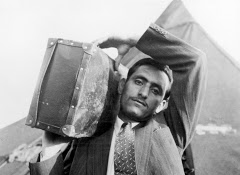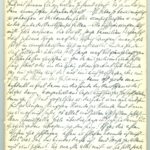Ofer Nordheimer Nur ~ Out Of Egypt
 Tablet. April 33, 2020. Earlier this year, more than 180 Jews gathered in the port city of Alexandria on Egypt’s Mediterranean coast to celebrate the reopening of the Eliyahu Hanavi Synagogue. This festive gathering for prayer, singing, and dancing was the largest Jewish event in Egypt since the demise of the community, most of whose members were pressured to leave in the 1950s. The opening of the synagogue, as well as an official ongoing authorization for an Israeli scholar to conduct research in Jewish sites of worship across Egypt, may signal no less than a new chapter in the history of the Jews in Egypt.
Tablet. April 33, 2020. Earlier this year, more than 180 Jews gathered in the port city of Alexandria on Egypt’s Mediterranean coast to celebrate the reopening of the Eliyahu Hanavi Synagogue. This festive gathering for prayer, singing, and dancing was the largest Jewish event in Egypt since the demise of the community, most of whose members were pressured to leave in the 1950s. The opening of the synagogue, as well as an official ongoing authorization for an Israeli scholar to conduct research in Jewish sites of worship across Egypt, may signal no less than a new chapter in the history of the Jews in Egypt.
The event took place in February under heavy security. The delegation was made up of Jews who were born in Egypt, accompanied by family, now living in Europe, Israel, the United States, and elsewhere. Two rabbis conducted the service, Rabbi Andrew Baker and the son of the last rabbi of the community of Alexandria, Rabbi Yosef Nefussi. The service was attended by the U.S. ambassador to Egypt, Jonathan Cohen, and also by former Israeli Ambassador David Govrin. During the service, 12 of the synagogue’s Torah scrolls were taken out and paraded, representing the 12 tribes of Israel.
Read more: https://www.tabletmag.com/sections/community/articles/out-of-egypt-nur
Ella Shohat ~ Remainders Revisited: An Exilic Journey from Hakham Sasson Khdhuri To Joseph Sassoon Semah
SPUI25 – Amsterdam – December 2, 2019
Keynote Lecture Professor Ella Shohat (New York University):
‘Remainders Revisited: An Exilic Journey from Hakham Sassoon Khdhuri to Joseph Sasson Semah’. She reflected on the significance of a place in the narration of the displaced Jewish-Iraqi community in the wake of overpowering political forces that, in one form or another, generated a historical vortex that rendered impossible a millennial existence in Mesopotamia.The enormous task of shepherding a Jewish community massively impacted by internal and external political pressures after the fall of the Ottoman empire and the establishment of the state of Iraq fell largely on the shoulders of the Hakham Bashi (the Chief Rabbi and also the President of the Iraqi Jewish Community), Sasson Khdhuri, the grandfather of artist Joseph Sassoon Semah. Although the majority of Iraqi Jews were dislocated in the wake of the partition of Palestine and the establishment of the state of Israel, the Hakham stayed to safeguard those who remained in Iraq, living through wars, revolutions, and a dictatorial regime that rendered hellish the situation of all Iraqis, but especially of Jews, existing as they did under the unrelenting suspicion of disloyalty. At the same time, some of the Hakham’s children moved to Israel where the Iraqi-Jews, along with Sephardi/Middle Eastern Jews more generally, experienced exclusion, rejection, and otherization as Arabs/ Orientals.
Against this backdrop, one can appreciate the self-exiling of some Mizrahim, including that of the grandson of the Hakham Bashi, artist Joseph Sassoon Semah, who left Israel in 1974 and has been living in Amsterdam since 1981. Tracing the familial passage from the Hakham’s decision to remain in Iraq to his grandson’s decision to depart from Israel encapsulates the fraught trajectory of a shattered community. These simultaneously in-place and out-of-place figures allegorize the unsettled story of Jewish-Iraq. In her keynote lecture Professor Shohat explored some of the motifs in the work of Joseph Sassoon Semah to illuminate the twinned loci of “Zion” and “Babylon” in the present-day formation of contradictory affiliations and paradoxical notions of “exile” and “diaspora.” The emphasis on a “Third Galut” in particular will serve to unfold a tale of a Jewish rupture from an accustomed Arab cultural geography, as re-membered by the descendants of those forced to abandon the land between two rivers, resulting in a lingering feeling of at once homelessness and at-home-ness.
Sasha Goldstein-Sabbah ~ Censorship And The Jews Of Baghdad: Reading Between The Lines In The Case Of E. Levy
 Abstract
Abstract
This study examines how members of the Jewish community of Baghdad used foreign newspapers and journals to bring to light and gain international sympathy for issues concerning the community and its relationship with the Iraqi regime during the early years of the Iraqi state (roughly 1930–1950). As an
example of this phenomenon, the article examines a 1934 case in which authorities arrested E. Levy, author of a letter to the Manchester Guardian telling of the confiscation of foreign Jewish newspapers sent to Iraq and the opening of letters addressed to Jews by postal officials. Subsequent to his arrest, the community was not discouraged from writing in the foreign press. On the contrary, members of the Jewish community, both anonymously and by name, wrote in Jewish and non-Jewish foreign presses imploring the world to intercede on Levy’s behalf and to bring to light the situation afflicting the Jews of Baghdad. This article argues that foreign media was a successful tool for the Jewish community of Baghdad as an unofficial channel of negotiation for both communal and individual rights.
Introduction
In Iraq, the British Mandate lasted from 1920 until 1932. In the long history of the region, this short period of the Mandate is often considered “the Best of Times” for the majority of Iraq’s religious and ethnic minority groups.1 For the Jewish community of Iraq, this period is often considered the apex of social and cultural integration into general Iraqi society. The community was bolstered by Jewish socio-economic mobility due to an extensive (Jewish) community-sponsored education system and an increase in white-collar employment opportunities in both the civil service and with foreign firms. It was also a time of relative intellectual freedom with little government censorship and increased access to foreign print media.
However, the end of the Mandate in 1932 and the death of King Faisal in 1933 were met with concern in regard to the future of the relatively pluralist society which had developed and, as some would argue, foretold the beginning of the end for over two thousand years of Jewish life in Iraq. The 1930s represented a time of unease as the new state experienced political instability and unrest. Although not to be compared with the political turmoil and violence of the 1940s, for the Jewish community of Baghdad there was a perceivable difference in state policy in regard to the Jewish community after the Mandate ended. These changes included greater legislation in regard to education, unofficial quotas on the amount of Jews employed in the civil service, the official banning of Zionism (in 1935) as an ideology, greater antiJewish sentiment in the local press, and the censuring of both Jewish periodicals and post from abroad destined for Jews residing in Iraq. Although much attention has been given to the history of the Jewish community of Iraq in academic circles during the past decade, little work has specifically focused on how the Jewish community (both on a communal and on an individual level) perceived and reacted to these changes in the Iraqi state during this liminal period from the end of the Mandate of the 1920s to the chaos of the 1940s, and particularly on the question of competing loyalties between the Iraqi state and Jewish nationalism as embodied in the Zionist political movement.
Read more: https://openaccess.leidenuniv.nl/Goldstein_Sabbah_2016.pdf
Joe Shamash, Iraqi Jewish Cultural Extinction And Identity.
Joe Shamash was born in Baghdad,Iraq in 1948. He lived there with his parents, five brothers, and two sisters until they fled in 1957. Joe, who is still a citizen of Iraq, shares reflections on his identity and his current relationship to Iraq.
Joe Shamash. Iraqi Jewish Cultural Extinction and Identity.
JIMENA Oral History and Digital Experience Project, 2012
(C)Copyright, JIMENA INC
Produced by Sarah R. Levin
for more information please visit: www.jimenaexperience.org/iraq
Point Of No Return: Jewish Refugees From Arab And Muslim Countries
 In just 50 years, almost a million Jews, whose communities stretch back up to 3,000 years, have been ‘ethnically cleansed’ from 10 Arab countries. These refugees outnumber the Palestinian refugees two to one, but their narrative has all but been ignored. Unlike Palestinian refugees, they fled not war, but systematic persecution. Seen in this light, Israel, where some 50 percent of the Jewish population descend from these refugees and are now full citizens, is the legitimate expression of the self-determination of an oppressed indigenous, Middle Eastern people.
In just 50 years, almost a million Jews, whose communities stretch back up to 3,000 years, have been ‘ethnically cleansed’ from 10 Arab countries. These refugees outnumber the Palestinian refugees two to one, but their narrative has all but been ignored. Unlike Palestinian refugees, they fled not war, but systematic persecution. Seen in this light, Israel, where some 50 percent of the Jewish population descend from these refugees and are now full citizens, is the legitimate expression of the self-determination of an oppressed indigenous, Middle Eastern people.
This website is dedicated to preserving the memory of the near-extinct Jewish communities, which can never return to what and where they once were – even if they wanted to. It will attempt to pass on the stories of the Jewish refugees and their current struggle for recognition and restitution. Awareness of the injustice done to these Jews can only advance the cause of peace and reconciliation.
(Iran: once an ally of Israel, the Islamic Republic of Iran is now an implacable enemy and numbers of Iranian Jews have fallen drastically from 80,000 to 20,000 since the 1979 Islamic revolution. Their plight – and that of all other communities threatened by Islamism – does therefore fall within the scope of this blog.)
Read more: http://jewishrefugees.blogspot.com/2019/06/
Emily Benichou Gottreich ~ Historicizing the Concept of Arab Jews in the Maghrib
 Jewish Quarterly Review – Volume 98, Number 4, Fall 2008 – University of Pennsylvania Press
Jewish Quarterly Review – Volume 98, Number 4, Fall 2008 – University of Pennsylvania Press
To begin, a few quick observations about the concept of the “Arab Jew” that prompt the current intervention: (1), it is largely an identity of exile; (2), it implies a particular politics of knowledge vis-à-vis the Israeli-Palestinian conflict and larger Zionist narrative(s); (3), it was originally theorized from within the frameworks of, and remains especially prominent in, specific academic fields, namely, literary and cultural studies.1While clearly recognizing the significance of the concept of Arab Jews to post-Zionist discourse, not to mention the groundbreaking contributions of those who have revitalized the term in recent years, this essay will nonetheless argue that these three factors have, to varying degrees, converged to keep the discourse about Arab Jews limited to the semantic-epistemological level, resulting in a flattened identity that is both historically and geographically ambiguous. Developed in conversation with and presented here alongside the related essay by Lital Levy, this essay questions the presumed cultural (i.e., historical) unity inherent in contemporary articulations of the Arab Jew from a Magrhibi perspective. That is, I will try to imagine how Arabness and Jewishness may have intersected in the Maghrib—and particularly in Morocco—at pivotal junctures in the past. Such efforts at historicization, it is hoped, will allow for much-needed nuance and specificity to accrue to this important identity-category, lending the concept of “Arab Jews” meaning beyond merely the ethical or political.
Read more: https://muse.jhu.edu/article/252138



